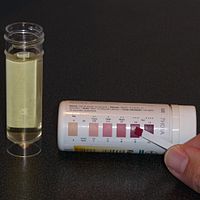
Selective analysis of aristolochic acid I in herbal medicines by dummy molecularly imprinted solid-phase extraction and HPLC.
Sign Up to like & getrecommendations! Published in 2017 at "Journal of separation science"
DOI: 10.1002/jssc.201700116
Abstract: In this study, surface molecularly imprinted polymers were prepared as the selective sorbents for separation of aristolochic acid I in herbal medicine extracts by a facile approach. A less toxic dummy template, ofloxacin, was used… read more here.
Keywords: extraction; analysis; molecularly imprinted; acid ... See more keywords

Isolation of aristolochic acid I from herbal plant using molecular imprinted polymer composited ionic liquid-based zeolitic imidazolate framework-67.
Sign Up to like & getrecommendations! Published in 2019 at "Journal of separation science"
DOI: 10.1002/jssc.201900554
Abstract: Aristolochic acid I is a toxic compound found in the genus of Aristolochia plants, which are commonly used as herbal cough treatment medicines. To remove the aristolochic acid I in extract efficiently and selectively, a… read more here.
Keywords: ionic liquid; molecular imprinted; imprinted polymer; polymer composited ... See more keywords

Effects of rhein and Rheum palmatum L. extract on the pharmacokinetics and tissue distribution of aristolochic acid I and its demethylated metabolite in rats.
Sign Up to like & getrecommendations! Published in 2020 at "Journal of ethnopharmacology"
DOI: 10.1016/j.jep.2020.113537
Abstract: ETHNOPHARMACOLOGICAL RELEVANCE Aristolochic acid nephropathy (AAN) is a kidney disease caused by the administration of plants containing aristolochic acids (AAs). Aristolochic acid I (AAI) is the main toxic component in AAs. Organic anion transporters (OATs)… read more here.
Keywords: tissue distribution; pharmacokinetics tissue; aai; aai aaia ... See more keywords

Dummy molecularly imprinted silica materials for effective removal of aristolochic acid I from kaempfer dutchmanspipe root extract
Sign Up to like & getrecommendations! Published in 2020 at "Microchemical Journal"
DOI: 10.1016/j.microc.2019.104463
Abstract: Abstract Aristolochic acid I (AAI), which is naturally produced in aristolochiaceae plants, has aroused many attentions due to nephrotoxicity. Dummy molecularly imprinted silica (MIS) materials have been prepared and applied to selectively remove aristolochic acid… read more here.
Keywords: kaempfer dutchmanspipe; root extract; acid; dutchmanspipe root ... See more keywords

Untargeted LC‐MS‐based metabonomics revealed that aristolochic acid I induces testicular toxicity by inhibiting amino acids metabolism, glucose metabolism, &bgr;‐oxidation of fatty acids and the TCA cycle in male mice
Sign Up to like & getrecommendations! Published in 2019 at "Toxicology and Applied Pharmacology"
DOI: 10.1016/j.taap.2019.04.014
Abstract: &NA; As the main toxic component of aristolochic acid, aristolochic acid I (AAI) is primarily found in Aristolochiaceae plants such as Aristolochia, Aristolochia fangchi and Caulis aristolochiae manshuriensis. AAI has been proven to be carcinogenic,… read more here.
Keywords: metabolism; fatty acids; testicular toxicity; acid ... See more keywords

CD4+ and CD8+ T Cells Exert Regulatory Properties During Experimental Acute Aristolochic Acid Nephropathy
Sign Up to like & getrecommendations! Published in 2018 at "Scientific Reports"
DOI: 10.1038/s41598-018-23565-2
Abstract: Experimental aristolochic acid nephropathy is characterized by transient acute proximal tubule necrosis and inflammatory cell infiltrates followed by interstitial fibrosis and tubular atrophy. The respective role of T-cell subpopulations has never been studied in the… read more here.
Keywords: cd4 cd8; cd8 cells; acid nephropathy; depletion ... See more keywords

Aristolochic acid induces mitochondrial apoptosis through oxidative stress in rats, leading to liver damage
Sign Up to like & getrecommendations! Published in 2021 at "Toxicology Mechanisms and Methods"
DOI: 10.1080/15376516.2021.1946229
Abstract: Abstract Aristolochic acid (AA) are persistent soil pollutants in the agricultural fields of the Balkan Peninsula. Preparations containing aristolochic acid are widely used for anti-inflammatory, diuretic, etc. To study the hepatotoxicity of aristolochic acid, 80… read more here.
Keywords: blank group; group; aristolochic acid; oxidative stress ... See more keywords

Exposure to aristolochic acid I is associated with poor prognosis of liver cancer patients.
Sign Up to like & getrecommendations! Published in 2022 at "Toxicology research"
DOI: 10.1093/toxres/tfac002
Abstract: The aristolochic acids (AAs), derived from Aristolochia and Asarum species used widely in herbal medicines, are closely associated with liver cancer. The major AA derivatives are aristolochic acid I (AAI) and II (AAII), which can… read more here.
Keywords: liver cancer; liver; prognosis; cancer patients ... See more keywords

Western diet exacerbates aristolochic acid-induced nephropathy in mice
Sign Up to like & getrecommendations! Published in 2023 at "Physiology"
DOI: 10.1152/physiol.2023.38.s1.5731588
Abstract: Aristolochic acid (AA) ingestion causes Balkan nephropathy, characterized by tubular injury and progression to chronic kidney disease (CKD). AA is taken up by proximal tubule cells via organic anion transport (OAT3) and induces p53-mediated DNA… read more here.
Keywords: western diet; kidney; physiology; aristolochic acid ... See more keywords

Macrophage interferon regulatory factor 4 deletion ameliorates aristolochic acid nephropathy via reduced migration and increased apoptosis
Sign Up to like & getrecommendations! Published in 2022 at "JCI Insight"
DOI: 10.1172/jci.insight.150723
Abstract: Aristolochic acid (AA) is the causative nephrotoxic alkaloid in AA nephropathy, which results in a tubulointerstitial fibrosis. AA causes direct proximal tubule damage as well as an influx of macrophages, although the role of macrophages… read more here.
Keywords: increased apoptosis; aristolochic acid; interferon regulatory; migration ... See more keywords

Phenylethylpyranone and Aristolochic Acid Derivatives from Aristolochia urupaensis
Sign Up to like & getrecommendations! Published in 2017 at "Journal of the Brazilian Chemical Society"
DOI: 10.21577/0103-5053.20170059
Abstract: A new pyranone, (S)-2-(4-hydroxyphenylethyl)-6-methyl-2,3-dihydro-4H-pyran-4-one, with unusual carbon skeleton, and three new aristolochic acid derivatives (7-O-methylaristolochic acid F, sodium 7-O-methylaristolochate F and sodium aristolochate F) were isolated from Aristolochia urupaensis (Aristolochiaceae) stems together with 31 known… read more here.
Keywords: phenylethylpyranone aristolochic; derivatives aristolochia; acid derivatives; aristolochia urupaensis ... See more keywords